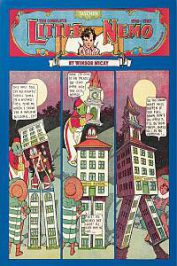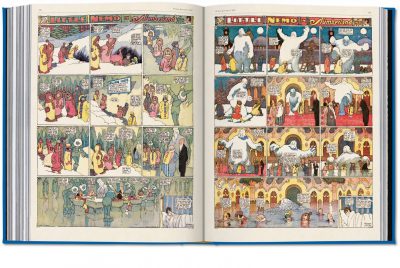If there ever was something close to psychedelic art, or representations and imaginations of a surreal and subconscious reality before the drug-induced states that became popular in art and fiction of the 1960s, then comic artist, cartoon producer and visual pioneer Winsor McCay (1869–1934) was the one who provided it, starting in 1905.
 He was the father of many pioneering comic series, his most successful and widely printed invention was a comic strip based on the weird dreams of a little boy. “Little Nemo in Slumberland” would leave readers of the 1910s – and today’s readers as well – breathless, as the surreal and incredible adventures in the psychedelic locations and strange combinations of the fashions, architecture and landscapes from all over the planet and diverse centuries were unheard of.
He was the father of many pioneering comic series, his most successful and widely printed invention was a comic strip based on the weird dreams of a little boy. “Little Nemo in Slumberland” would leave readers of the 1910s – and today’s readers as well – breathless, as the surreal and incredible adventures in the psychedelic locations and strange combinations of the fashions, architecture and landscapes from all over the planet and diverse centuries were unheard of.
No comic or cartoon artist before him dared or had the artistic means to present such colorful and “uncanny” stories and places.
The volume contains all episodes of The New York Herald years (1910 – 1911). Furthermore, all of Little Nemo’s adventures from McCay’s period for the papers of William Randolph Hearst (1911 – 1914) are here, a time when the comic series was briefly renamed “In the Land of Wonderful Dreams,” but remained true to its protagonists and story lines.
The final chapter of the volume, with strips from 1924 – 1927, were produced for The New York Herald Tribune again and presents the series with its original title “Little Nemo in Slumberland.”
This book is a sequel to Winsor McCay. The Complete Little Nemo 1905–1909 (2017) that provided episodes of the Slumberland series only. 
Volume two here adds the fantastic “Airship Adventures” Little Nemo experiences, a section of the story that came to life when McCay was hired by James Gordon Bennett Jr. His printing house owned The New York Herald and The New York Evening Telegram; both papers contained McCay’s strips.
The New York Herald for decades would own the most advanced and best printing presses in the country, and fortunately the Little Nemo stories with their countless little details and tiniest objects hidden and arranged within the panels, would be produced there.
 The book comes with almost 340 pages of beautiful large-format reproductions; still, it provides less than a page of information on the artist, the series or its reception.
The book comes with almost 340 pages of beautiful large-format reproductions; still, it provides less than a page of information on the artist, the series or its reception.
All of this is subject to the complete edition, namely
(Winsor McCay. The Complete Little Nemo by Alexander Braun (2014), introducing all of Little Nemo’s adventures, with a very elaborate text on artist McCay (150+ pages) that covers all parts of his interesting biography).
 The complete lot of 329 nocturnal adventures that Nemo dreams his way through – until he is woken up in every last panel of the story – from 1910 to 1927 are collected here. The quality and the colors are excellent, each story and full-color page good enough for any museum of modern art.
The complete lot of 329 nocturnal adventures that Nemo dreams his way through – until he is woken up in every last panel of the story – from 1910 to 1927 are collected here. The quality and the colors are excellent, each story and full-color page good enough for any museum of modern art.
Editor Alexander Braun, a visual artist himself, who also authored this volume, has again done a good job by putting those artifacts together.
This is a clothbound XXL 9 pound – 13.8 x 1.4 x 17.6 inch – multilingual edition (English, German and French).
Review by Dr. A. Ebert © 2019
Alexander Braun (ed.) Winsor McCay. The Complete Little Nemo 1910–1927. Taschen, 2019, 334 p., ISBN 978-3-8365-7611-6
